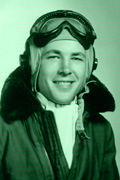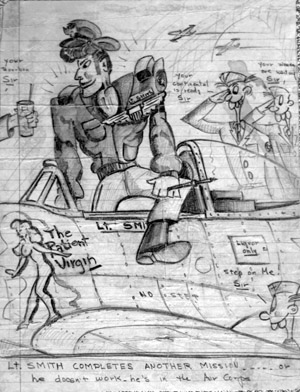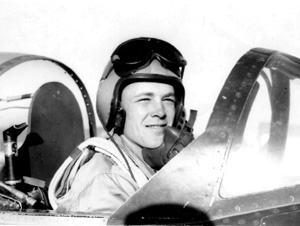Chapter 1 >
Autobiography home >
NF-104 home

Chapter 1 -
Training for War click on the links below for more of the story...
|
||||||||||||||
Advanced with Jet Speed
Advanced Training, Williams AFB, Arizona, Jan- June 23,1950 My best friend in High School, Phil Thormahlen told his brother Paul that I was going into jets. Paul had been blown off the deck of the Carrier Yorktown in the war, but miraculously survived with significant damage to an arm and leg when his body was dragged near the ships propeller. He was studying to become an architect and sent me a pencil-sketch cartoon, which is only slightly the worse for wear.
There were a lot of talented, dedicated and brave people who stimulated my respect for the Air Force over the course of my career. It started on arrival at Williams, because our Commander, Colonel H.R. Spicer, was not only an outstanding fighter pilot in the air over Germany, but an exceptional hero and leader as a Prisoner of War in Germany. When shot down over the English Channel he spent 2 days drifting into enemy hands on a shore in France, with frozen feet. Later, he was sentenced to death before a German firing squad in a Luftstalag (Flyers’ Prison) as punishment for actions in leading his fellow prisoners and narrowly avoided execution when liberated by Russians. It didn’t take long for me to know I got the best instructor in the world, Lt. Joseph Moore, who became competitor as well as instructor, as I gained his confidence. He continued to mold us into fighter pilots in the T-6, in preparation for transition to jets. Soon our growing skills in acrobatics and formation were becoming “Fighter Tactics” training, for the days not so far in the future when some would use them in the real thing. We had both day and night navigation, wherein we were sure to find our way to Nellis AFB, since the instructors could afford a bit of Las Vegas nightlife and gambling, even if the students couldn’t on our $75 a month; no allowance for family and no raise for promotion to advanced! Near the end of our T-6 training I got my final Check Ride, a night flight with another instructor. I was really confident in that airplane, to the point of being cocky. I was truly proud of my fighter pilot’s tight landing patterns, pulling g’s in a tight 360 degree diving turn, with idle power through a series of touch and go night landings. Joe seemed proud, and I was pleased, when he passed along to me the comment from the check-pilot that I would be a fine fighter pilot, if I out-lived my confidence.
Jeff became one of my memorable object lessons in life. He had been first to solo in my class at basic, because he came in with flying experience, but seemed satisfied with his abilities from the start. A number of us who were less confident from the start, soon passed him by in flying skill. Before we transitioned to jets, an auspicious event occurred for me when I scored highest in a very special landing contest. That unique event really put the pressure on a few of us! One cadet was designated by each instructor to be evaluated and graded in a series of landings. Senior officers judged approach and landing from their position close to the runway at the touchdown stripe. Evaluation included pattern, “full power-off” compliance, radio procedures and touchdown distance from the target, 3-point touch attitude and smoothness plus quick recovery with proper procedures on go-around. The instructors/section monitors purposely tried distractions on the opposition team, including radio calls that required answers at most inopportune times. That required the pilot to pick up and replace the microphone to respond, adding distractions to stress of competition. That was no small-time event when we learned it was the result of a big-time beer- party wager between the instructors and commanders of the two competing Flight Training Sections! At that moment it seemed the most important flight of my training, except for the original 40-hour check in basic. My individual score, not only solidified my confidence in graduating, it affected Joe from that moment on, to allow me great latitude in training, for faster learning.
We were the 4th jet class and the norm had been 30 total jet hours per student. Class 49C was stuck with “49 Crash” because they had so many fatal accidents in their first assignments which drastically changed our training. Because of the limited number of jet trainers, a group of us were given 65 jet hours and the majority had to complete training in the T-6, a real disappointment to them. After a T-33, dual-pilot jet trainer flight with Joe in back, it was time for my checkout in the single seat F-80A. It was a little beauty of an airplane with a small, tight cockpit, no ejection seat, and canopy that felt as close as my helmet. That flying machine felt strapped to my butt, not overloaded with power for quick acceleration, but it could really move with time. Joe escorted me in another F-80, the procedure for first solo. By that point I had absolute confidence that I would graduate, in large part because I realized that Joe did, too. After I finished a set of planned maneuvers, he surprised and called me to “get in trail!” We had become competitors and rat raced often in the T-6 so I knew what was about to happen. In spite of lacking experience I was determined not to let him shake me off his tail and beat me. Joe started hard scissors which are a violent set of unexpected and quick rolling maneuvers combined with fast breaking, high “g” turns, reversing frequently and unexpectedly. The split second delay before the follower can recognize and respond to change gives an opportunity for the lead aircraft to force the adversary out of sync. By diminishing the advantage and taking full advantage, the front aircraft can either escape or even swap position with a fast roll. This was not necessarily a good defense in actual air combat, except as a last resort, because the guy in back could pull his trigger whenever the other passed in front. But in training it was a good exercise of skill in maneuvering. Getting so confident with this during rat races in training probably cost me one, maybe two actual kills, later in air combat. I suddenly realized I was about to overrun Joe and lose to him, so in my determination, I jerked the throttle back, fast and hard! The only jet fighter that the Air Force ever made without a “throttle-stop” to prevent inadvertent shutdown of the jet engine was the F-80 model, which had a gentle ramp not necessitating a conscious outboard move while pulling to shut down. I immediately discovered my folly when I heard an unexpected sound for a jet engine in flight ... Silence! I accomplished my goal not to overrun, but the wrong way! I figured we were not supposed to be rat-racing on my initial flight, so I innocuously called Joe to ‘check me out’. I let him know my situation with only engine cut hand-signal, hand sliced across throat, then made an air start, without verbal communication. Air start was a simple process in later jets, but the 80A had a strange fuel control with an “I-16” switch that made ground starts tricky and air starts worse. Engine temperature control by jockeying the throttle was very dicey, so I was much relieved when it was successful, as I am sure Joe was. I was pleased but not proud of the outcome, and I guess Joe was because we never discussed it.
As we were preparing for jet transition, I had learned more about instrument flying, which was transitioning from an event of undesirable reality of the WW II fighter era into a necessity and routine operations for fighter pilots. The gyroscopes in the old Attitude Indicators (AI) would tumble whenever the airplane strayed far from level flight, leaving the pilot with very inadequate information for recovery. We practiced under the hood by closing our eyes as the instructor put the aircraft out of control, even trying to identify a spin and recover. But it would be a very dangerous situation in the clouds with a tumbled and useless attitude reference, a real possibility when inadvertently entering a thunderstorm, for example. Our F-80s were equipped with a tumble-free AI and soon after, navigation aids were improved, making flight in real bad weather far less hazardous, thus more routine. These new AIs merely performed a 180 degree rolling reorientation whenever the airplane passed through vertical, in a loop, for instance. As a result, it was possible with practice to do acrobatics in the blind. That new instrument had one flaw that cost of lives of a few pilots, until a later upgrade. The pilot had to move the stick in the direction away from the horizon to correct toward the real horizon, absolutely contrary to normal blind flying, and especially dangerous in the final seconds of an instrument approach to landing, where a distracted pilot was apt to revert to habit. That anomaly was eliminated in AI design in later jet fighters. Learning to adjust for that AI variation proved to be a valuable lesson in adaptability throughout my career. I learned to reorient my perspective to satisfy reality. In this case reality was the result of a fixed ball (gyroscope) fixed in space with the airplane and I pitching about it. Once that clicked I was more reactive in responding to changes, then and thereafter, when I encountered new flight situations. That adaptability paid off during a very exciting test program in my future. Another event portrays a sense of how competitive our relationship grew in the six months that Joe and I were together. During jet training, the primary sin for student or backseat instructor was landing touchdown on the dirt approaches short of the concrete. Although our runway was kept smooth at that edge, landing just a little short could be a fatal mistake at many airports. A not quite equal goof was to blow dust while landing; a sign of a low approach and full throttle trying to avoid a short touch down. The instructors caught as much flack as the students, so they were very conscious of these mistakes. We are talking about the age through and after WW II, when a perfect fighter pilot pattern was to fly directly down the runway, chop throttle to idle over the landing point and never touch it again, while making a rapid rolling break into a 3 or 4 g tight circle to touchdown. The only difference with jets is the lack of a propeller for deceleration, necessitating speed brake as the replacement for a real tight pattern, the mark of excellence! The only thing changed was we were no longer permitted to approach on the deck and break upward, like a chandelle, but instead we stayed level at 1000 feet in our tight 360 pattern, until rolling onto the final approach. A disadvantage in the early jets was very slow response from idle up to effective power levels above 90%. Just before I touched down after one of my dual flights with Joe, I began to feel the throttle moving forward of idle, the only time I ever had Joe touch controls while I was flying with him. I pulled hard and held it firmly in idle, and glided to a good landing on the runway. Joe didn’t even mention it, but all hell would have broken loose if I had been wrong. I was confident we would make it and if we added power we blew dust! I had a much better view to judge from the front seat than he had in the back and our touchdown was close to the edge. In addition to my great respect for him and his rank of first lieutenant, I found a special friend in Joe Moore, and felt an affinity with his wife Gilda and young son “ Joey”. Graduation was the chance for Martha to meet them, but the last time I ever saw Joe Moore, who was killed during a training flight in an F-51D, in preparation for a combat assignment in Korea, only months before I departed for that theater and about a year after graduation. He provided me a great stimulation to become a good fighter pilot and I solidified his memory in my mind with two things. A picture of his son, Joey, which I received from Gilda and kept in my wallet for many years, was one. The other was his choice of encouraging, endearing, and brief words when he signed my Class Book at graduation .... “My End Product”.
I had once more seen Gilda, a lovely lady, at home with her husband, Col. Tom Personnet, at Andrews AFB in 1962. He was the Base Commander and I was there with 8 other test pilots who were the Air Force nominees to NASA as the first Gemini Astronauts. I was able to make contact with Tom and Gilda a few years ago and claim two great pen pals. With an unexpected phone call from 30 miles away, they recently became real folks again, and arrived at our home, a wonderful and emotional experience for the four of us. And I learned that “Little Joey” had become an airline pilot, carrying on his Dad’s chosen profession.
I am reminded of the Acro Jets aerobatic team based at Williams, and their leader Bruce Carr, a WWII Ace and their Slot Pilot Lefty Sellinger, who was the idol of the cadets. I couldn’t wait to learn to fly formation acrobatics. A few years back Martha and I met Bruce Carr at an Air Force Association dinner honoring Aces and enjoyed the pleasure of Bruce and his wife in our home, after all those years. Recently, I read the story of how he was shot down in Europe and hid out in the woods overnight, near a German airdrome, only to sneak in at dawn’s light, steal an ME-109 fighter and, without benefit of understanding German, managed to take-off and return to his base in France. He had to belly land even though he had guessed right on how to retract the gear he could not unlock and lower it, especially hastened by friendly anti-aircraft fire anxious to shoot down a Hun. The recent event of his passing on diminishes the famous WW II flyers by one more of that group’s best known. Graduation, with Martha there after 6 more months of separation was very special for us exciting event, most of all, a chance to become a family for the first time. One of the rituals that remained in my memory was how each new pilot had gotten in line to borrow $600 from the Bank of Ft. Sam Huston, San Antonio, and moved to the other line, a San Antonio tailor’s, to spend it on our uniforms. That was one shrewd bank, which we retained for more than 50 years, until it was acquired, or I should say absorbed, in the new world of bigger business. I left Williams with orders-in-hand to fly F-80C in Japan, and a 30-day leave before reporting. We made it back to Wichita in the old Plymouth, which was its last foray, but not ours. The Korean War had begun with graduation, which changed things because I received a telegram that rescinded my orders. I was reassigned to fly the most advanced fighter in the world, the swept wing F-86A Sabrejet. I could have hoped for nothing more than to fly America’s first ‘bent wing’ airplane. One had landed at Williams from the 1st Fighter Wing based at March Field, CA and we had all visited it on the line, drooling over that beautiful swept winged creature. Once again good luck prevailed in my flying career. |
| previous section | next section |


.jpg)
.jpg)
.jpg)

.jpg)
.jpg)